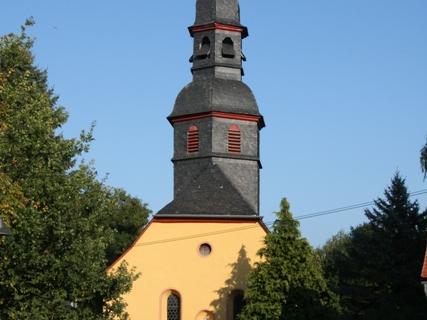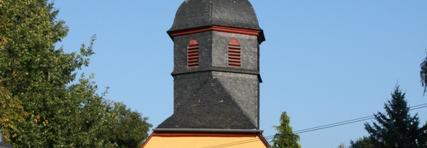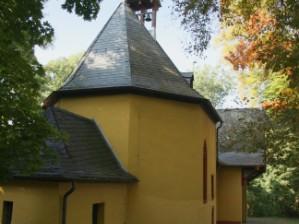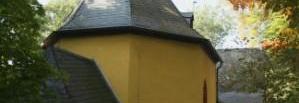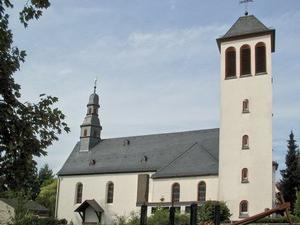The Pilgrimage Church in Sternbach
This is none other than the house of God, and this is the gate of heaven.
(Genesis 28:17b)
The church in the lost village of Sternbach
This custom of donating and exchanging of properties continued. In 1274, Werner von Ballersheim received half the property and in 1292, the Ilbenstadt Church sold the whole property in Sternbach to the Abbey of Arnsburg5).
At that time, there weren’t any free farmers left in Wickstadt but in Sternbach, a number had survived. The Earl of Solms inherited this after the Falkensteiners, the descendents of Münzenberger, died out in 1418. Thereafter many quarrels ensued, mainly regarding the rights of the farmers. During this turbulent period, the village of Sternbach died out. The last message is from 1545.
Records show that the Abbey of Arnsburg was the patron of the church and parish from 1448 till 1803. The parish included Wickstadt, Ossenheim, Bauernheim, Nauheim, Friedberg, Weckesheim, Leidhecken, Florstadt and Staden. With the dissolution of the Abbey in 1803, the House of Solm-Rödelheim-Assenheim inherited the property in Solms6), Sternbach and Wickstadt.
The church in Sternbach can be found today secluded in the woods, west of the Wickstadt estate.
Remains of an enclosure encircling the church can be discerned. It is however unknown if it was erected for defence purposes. It can just be assumed that the original church was built where it stands today. It appears to have been built around 1200, during the Roman Empire with thick walls, semi-circular arches and small window openings in the south walls. The flat, long and rectangular nave (main body of the church) is the oldest part of the church. Later in the Gothic times, renovations and alterations were carried out - the sanctuary was built in 1455 by the 29th abbot, Jo(h)annes de Wickstadt. The sanctuary has a ⅝ polygonal termination and a rib vaulted ceiling. Also noticeable are different late Gothic traceried windows on the north side of the nave. Further renovations were carried out in the 18thcentury to the atrium7), similar to the Swiss Chalet style. The dormer window in the sanctuary was also built in this era.
The interior of the church has an elevated choir and the altar from the beginning of the 18thcentury. The altar is carved from an alabaster relief, and portrays St. Gangolf, to whom the church is consecrated to. In the middle is a splendid and magnificent forged grid from 1718, and behind it an original painting from the 15th century of the Blessed Virgin Mary standing. This painting was restored in the Baroque times and again in the 19th century. Records from the year 1845 mention a holy receptacle8) which was also a vera icon9) depicting Jesus Christ. Lastly the built-in wall niche from the time the choir was built is worth mentioning.
The fact that St. Gangolf still stands today is due to various factors. For one, it is still used as a pilgrimage church and secondly thanks to Virgin Mary, the Blessed Mother of Sternbach10). You can still see 2 stones from the path from Wickstadt to Sternbach from the year 1725 in the atrium. A wall painting depicting the Annunciation (the revelation to Mary) Luke 1:31 can be found on the tympanum.
At the front of the church is a small chapel with decorative figures showing the resurrection of Christ from the beginning of the 18th century. Another remarkable work of art is a wooden limewood sculpture of the Lamentation of Christ from the 17thcentury11). Unlike most other Lamentation of Christ pictures, Mary is not kneeling while cradling her son’s body but half-kneeling. It still serves as inspiration for the pilgrimages today.
1) "Sterenbach", "Stewenbach", it is unclear if the references are to Sternbach; it could also refer to a person’s name "Sterro". Refer to Andriessen, Klaus, Siedlungsnamen in Hessen, Verbreitung und Entfaltung bis 1200, Dissertation Marburg, 1990.
2) Sante, G.Hb historical Cities, Hessen, Book VI, Stuttgart, 1976, page 428.
3) Property, estate about 30 "Morgen" (1 "Morgen" is approx. 2500 m²) according to Abt R. Kolb: Gärtner, Otto, Kloster Arnsburg in der Wetterau, Königsstein, o.J.
4) Juridicial district
5) Lummitsch, Rudolf, History of the City of Assenheim, page 204 ff and page 220 ff, Niddatal, 1977.
6) Property of approx 700 „Morgen“ (1 "Morgen" is approx. 2500 m²)
7) Dehio, G. Hb. Der Deutschen Kunstdenkmäler, Hessen, München 1982, page 916; Denkmaltopographie BRD, Hessen, Wetterau, 11/2, Wiesbaden, 19999, page. 844.
8) Holy receptacle.
9) Latin/greek (eikon) „true image“, often used for acheiropoieta, literally “not-handmade” or Icons Not Made by Hand, Wagner, Georg, W.J., Die Wüstungen inm Großherzogtum Hessen, Darmstaft, 1854, page 320. Broackhaus, Junst, Mannheim, 2001, page 15.
10) Sante, a. a. 0.
11) Dehio, a. a, 0,
